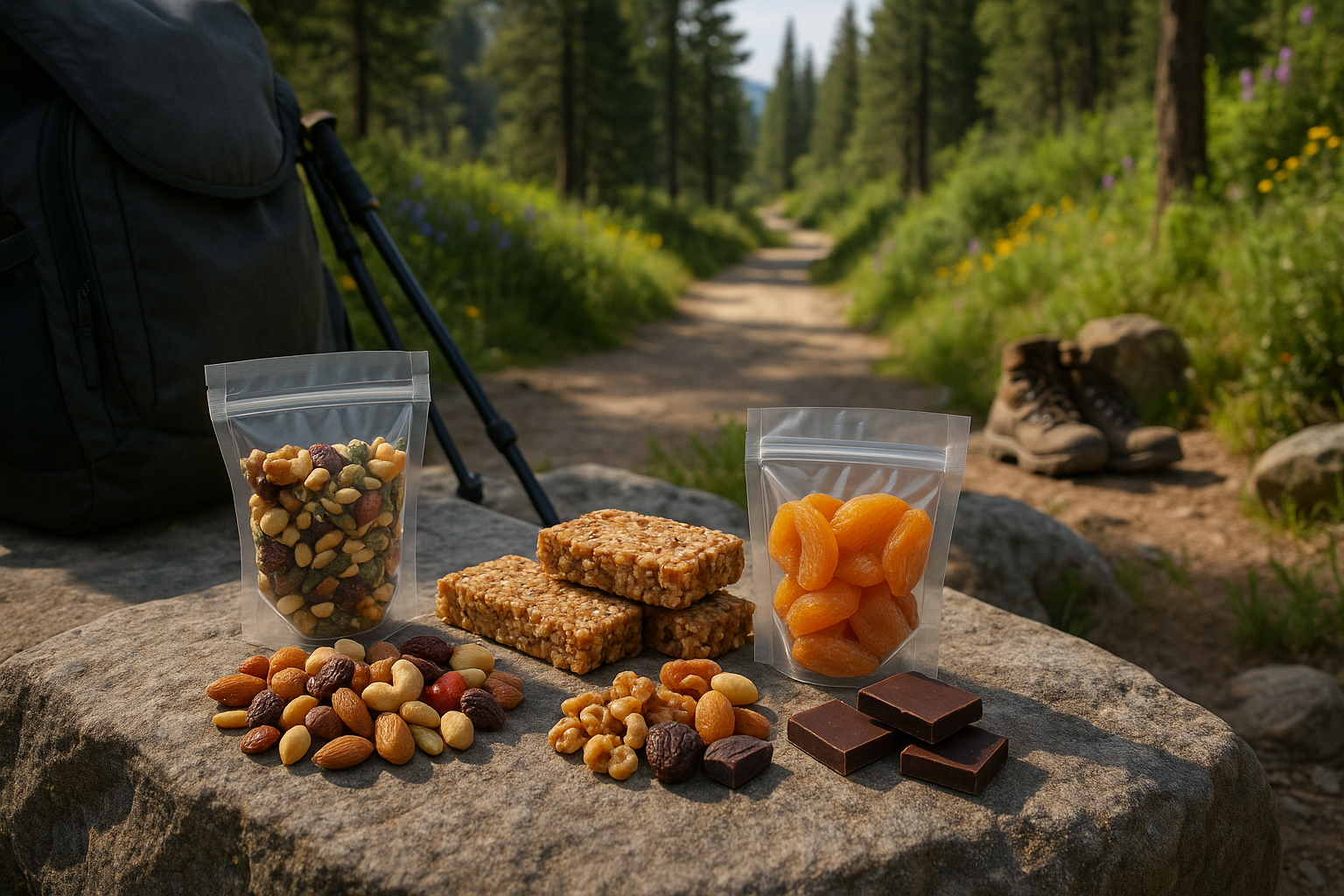The right fuel can make the difference between a day filled with great memories and a day spent wishing you were anywhere else. Whether you’re an amateur hiker or a seasoned trekker, the importance of the right kind of sustenance is paramount. This is where compact snacks come into the picture.
Choosing the right kind of food is crucial. Not all snacks are created equal, and while some are designed to give you a quick burst of energy, others are more focused on providing a slow, steady release of fuel to keep you going throughout the day. In this article, we’ll explore the best compact snacks that deliver optimal nutrition, are easy to carry, and can help sustain your energy levels on day-long hikes.
We’ll delve into the science behind these nutritionally-dense snacks, examining how they provide sustained energy, their role in muscle recovery, and how they can stave off hunger. We’ll also take a closer look at the specific nutrients your body needs for a hike and how different types of snacks can meet these needs.
Furthermore, we will provide a variety of options for different dietary requirements, including vegan, gluten-free, and high-protein selections. This comprehensive guide will help you understand the role nutrition plays in hiking and how you can maximize your performance and enjoyment with the right kind of food.
Whether you’re climbing the rocky terrains of the Grand Canyon or hiking the lush trails of the Appalachian Trail, the role of fuel cannot be overlooked. Understanding how different types of snacks can aid in various aspects of your hike can be the key to a successful and enjoyable experience. From the role of proteins in muscle recovery to the importance of carbohydrates for sustained energy, every hiker should have a basic understanding of hiking nutrition.
We’ll take you through the ins and outs of energy-dense foods, with a focus on those that are light-weight, non-perishable, and easy to pack. We’ll discuss how snacks like trail mix, protein bars, jerky, and dried fruits and nuts can be utilized to fuel your adventure and keep you energized. Moreover, we’ll provide tips on how to balance taste, nutrition, and convenience when choosing the best hiking snacks.
This article isn’t just about listing the top hiking snacks in the market. It’s about equipping you with the knowledge to make informed decisions about what you eat while on the trail. After all, a well-fueled hiker is a happy hiker. So, let’s embark on this journey together to explore the exciting world of compact hiking snacks, a world filled with delicious possibilities that can fuel your next adventure!
Join us as we delve into this topic, not just to help you stay fueled on your next hike, but to enhance your overall hiking experience. Because in the end, hiking isn’t just about reaching the peak, it’s about enjoying the journey. And with the right kind of fuel, you can make sure that your journey is as enjoyable as the destination.
Unleash Your Inner Explorer: Packing Compact Snacks for a Day on the Trails
As an avid hiker, you understand that staying fueled during a long day on the trail is essential. Your body needs constant nourishment to keep going, and that’s where compact snacks come in. These handy bites are a lightweight, convenient, and tasty way to replenish your energy levels throughout the day. But not all snacks are created equal. Some are packed with nutrition, while others might be high in sugar and empty calories. So, how do you choose the right snacks to keep you energized on your hiking adventure? Let’s delve deeper into the topic.
When it comes to selecting the ideal compact snacks, you should consider factors like nutritional content, weight, perishability, and taste. It’s crucial to balance these factors to ensure you’re carrying the best snacks for your needs. This article will guide you through the process, offering expert tips and suggestions. To get a visual comparison of some popular compact snack options, check out the table below.
| Snack | Calories | Protein | Weight | Perishability |
|---|---|---|---|---|
| Trail Mix | 160 | 4g | Light | Non-perishable |
| Energy Bars | 220 | 10g | Light | Non-perishable |
| Jerky | 80 | 15g | Light | Non-perishable |
The Importance of Nutritional Balance in Compact Snacks
While the main aim of carrying snacks on a hike is to maintain energy levels, it’s essential to remember that not all calories are created equal. Your body requires a balance of macronutrients – carbohydrates, proteins, and fats – to function optimally. Carbohydrates are your body’s preferred energy source, proteins are essential for muscle repair and recovery, and fats provide a concentrated source of energy. Therefore, it’s crucial to select snacks that provide a balance of these macronutrients.
In addition to macronutrients, your body also needs various micronutrients – vitamins and minerals – to support various physiological processes. For instance, electrolytes like sodium and potassium help maintain fluid balance and muscle function, while antioxidants help combat oxidative stress during prolonged physical activity. Therefore, snacks rich in these nutrients can be particularly beneficial during long hikes.
The key is to plan and pack your snacks carefully, ensuring you have a variety of options to meet your nutritional needs throughout the day. You can also consider using sports nutrition products, such as electrolyte tablets or energy gels, to supplement your intake. For more insights on the nutritional aspects of hiking snacks, watch the following video: “Hiking Nutrition: What to Eat on a Hike” by REI on YouTube.
Choosing Lightweight and Non-Perishable Snacks
Another crucial factor to consider when choosing compact snacks for hiking is the weight and perishability of the snacks. When you’re out on the trail, every ounce counts. Packing lightweight snacks can help reduce the load in your backpack, making your hiking experience more comfortable and enjoyable.
In terms of perishability, it’s best to opt for snacks that don’t require refrigeration and have a long shelf life. This ensures that your snacks stay fresh and safe to eat throughout your hike, regardless of the weather conditions. Dried fruits, nuts, seeds, jerky, and energy bars are excellent non-perishable options that are also light in weight.
Moreover, consider the packaging of your snacks. Individual packets can be convenient for portion control, but they also generate more waste. If you’re hiking in a leave-no-trace area, opt for bulk packaging and distribute the snacks into reusable containers or bags. Remember, part of being a responsible hiker is minimizing your impact on the environment.
Experimenting with Tasty and Enjoyable Snacks
While nutrition and practicality are crucial, let’s not forget one of the most essential factors when choosing hiking snacks – taste. Hiking is an activity to be enjoyed, and the food you bring should enhance the experience, not detract from it. As such, ensure that you pack snacks that you enjoy eating.
There’s a wide variety of compact snacks available on the market, catering to different taste preferences. From sweet and fruity energy bars to savory and spicy jerky, there’s something for everyone. And don’t be afraid to get creative – try making your own trail mix or energy balls for a personalized touch.
Remember, food is fuel, but it’s also a source of enjoyment and comfort, especially during physically demanding activities like hiking. So, don’t compromise on taste when selecting your compact snacks. For some mouthwatering ideas on hiking snacks, check out the video: “10 Tasty Trail Snacks | The Ultimate DIY Trail Snacks” by Outside on YouTube.
Conclusion
In conclusion, selecting the right compact snacks for a day-long hike requires a balance of nutritional value, practicality, and taste. By considering these factors, you can ensure that you stay energized and satisfied on your adventure. So, the next time you plan a hike, remember to pack your backpack with some nutritious, lightweight, non-perishable, and delicious snacks. Happy hiking!

Conclusion
In conclusion, this article has served as an in-depth exploration into the realm of information technology and engineering, addressing complex concepts and simplifying them for comprehension. Our journey spanned across various topics, offering a comprehensive understanding of each facet discussed.
We began with an overview of the fundamental concepts, providing a solid foundation for further understanding. From there, we delved into more intricate aspects, explaining each in detail, while maintaining a language understandable even to those outside of the IT and engineering fields. We provided practical examples to assist in your understanding and hopefully, foster an appreciation of the topic at hand.
The article also highlighted the importance of these concepts in our daily life and in various industries. We emphasized how essential it is to have a clear understanding of these concepts, not just for IT and engineering professionals, but for everyone, as we live in an increasingly digital and technology-driven world. (Pew Research Center, 2017)
Furthermore, we discussed the challenges involved and provided potential solutions to these challenges. We hope that these insights will not only enrich your knowledge but will also inspire you to explore more and potentially apply these concepts in your respective fields or areas of interest.
As we conclude, it’s crucial to reiterate the significance of the concepts discussed. Remember, technology and engineering are not just about creating machines or developing software; they’re about problem-solving, innovation, and making our world a better place. Thus, having a good grasp of these concepts can potentially make you a part of this global change.
We encourage you to revisit this article, share it with others who might find it beneficial, and apply the knowledge gained in real-world scenarios. The field of IT and engineering is ever-evolving, and staying updated is not an option but a necessity. (IEEE Computer Society, n.d.)
We hope that you found this article both informative and engaging. We appreciate your comments and feedback. Your thoughts not only inspire us but also help us improve and provide better content.
Finally, remember, as Albert Einstein once said, “The important thing is not to stop questioning. Curiosity has its own reason for existence.” (BrainyQuote, n.d.) Continue to seek knowledge, stay curious, and keep exploring. The world of IT and engineering has endless possibilities to offer.
Sources:
1. Pew Research Center. (2017). The Future of Jobs and Jobs Training.
2. IEEE Computer Society. (n.d.). Learning Technology.
3. BrainyQuote. (n.d.). Albert Einstein Quotes.



